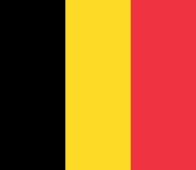 | |
| Use | National flag |
|---|---|
| Proportion | 13:15 |
| Adopted | 23 January 1831 |
| Design | A vertical tricolour of black, yellow, and red. |
 | |
| Use | Civil ensign |
| Proportion | 2:3 or similar |
| Design | A vertical tricolour of black, yellow, and red. |
 | |
| Use | State ensign |
| Proportion | 2:3 |
| Adopted | 1950 |
| Design | As above, with the central pale defaced by a lion rampant ensigned by a crown, both sable (black), the lion armed and langued gules (red). |
 | |
| Use | Naval ensign |
| Proportion | 2:3 |
| Adopted | 23 February 1950 |
| Design | A yellow saltire on a white field, bordered above and below in red and to the left and right in black, charged on the top with a crown above crossed cannons and on the bottom by a fouled anchor. |
The national flag of the Kingdom of Belgium is a tricolour consisting of three equal vertical bands displaying the national colours: black, yellow, and red. The colours were taken from the coat of arms of the Duchy of Brabant, and the vertical design may be based on the flag of France. When flown, the black band is nearest the pole (at the hoist side). It has the unusual proportions of 13∶15.
In 1830, the flag, at that time non-officially, consisted of three horizontal bands, with the colors red, yellow and black. On 23 January 1831, the National Congress enshrined the tricolor in the Constitution, but did not determine the direction and order of the color bands. As a result, the "official" flag was given vertical stripes with the colors black, yellow and red.